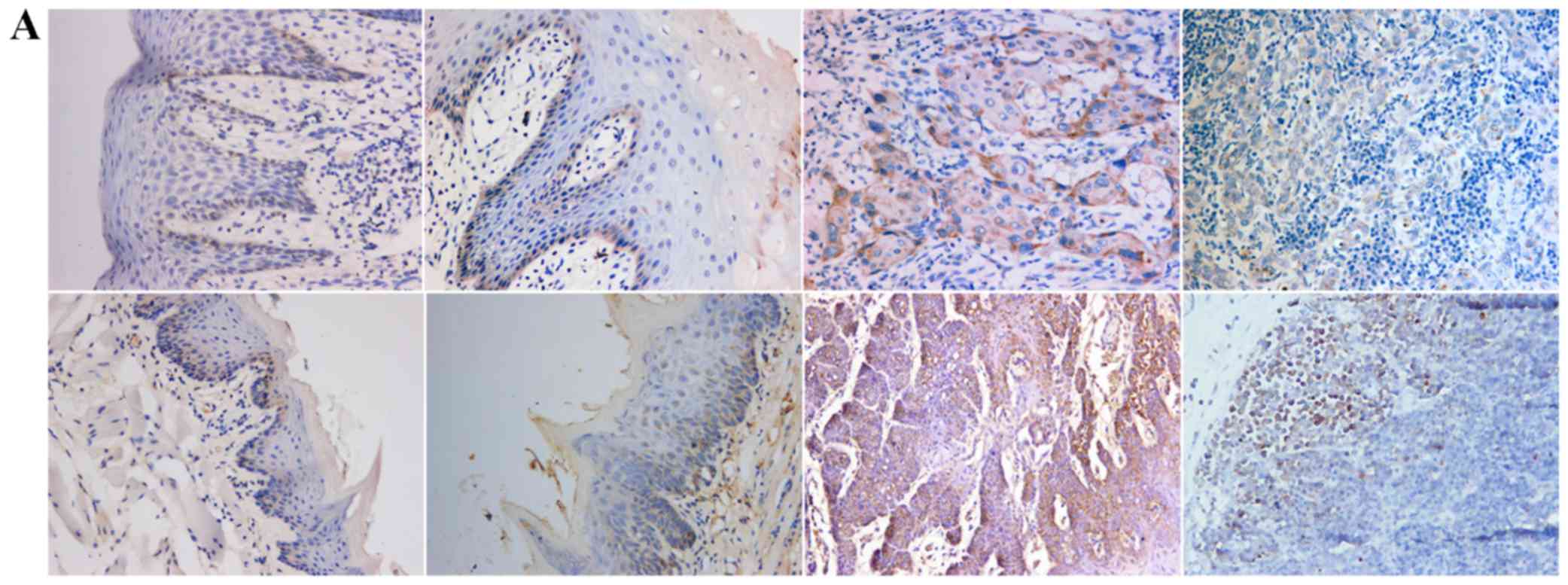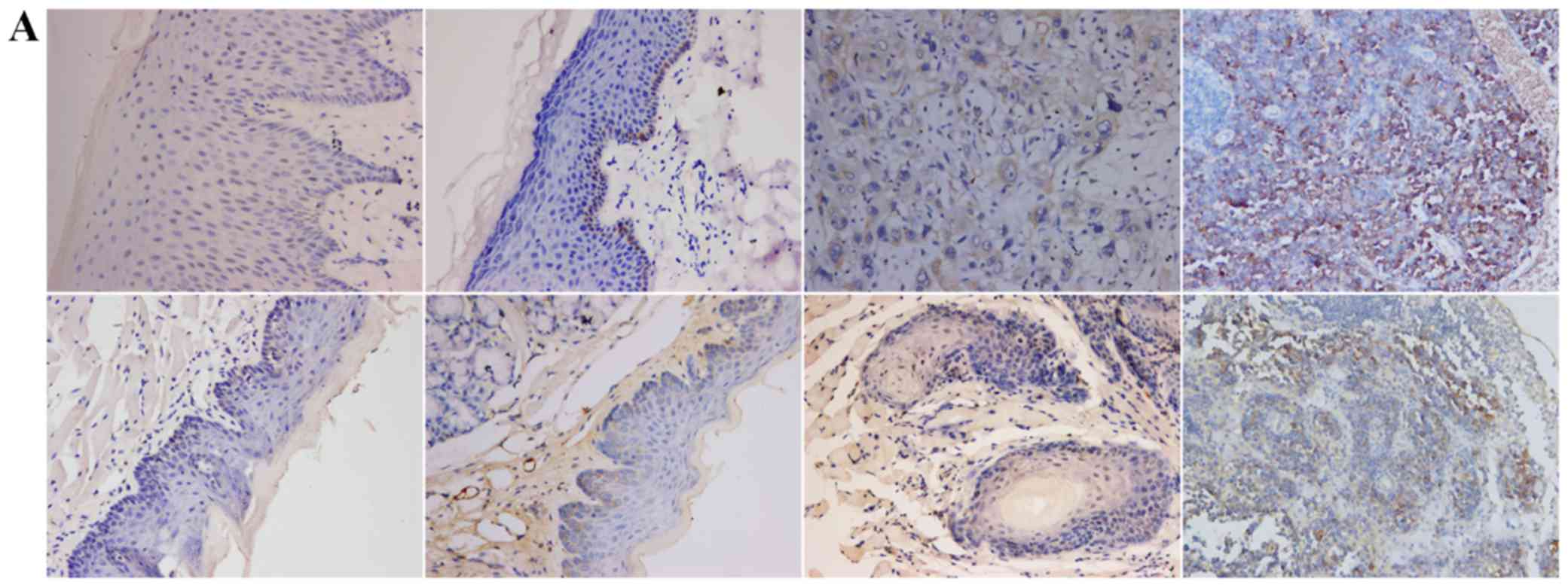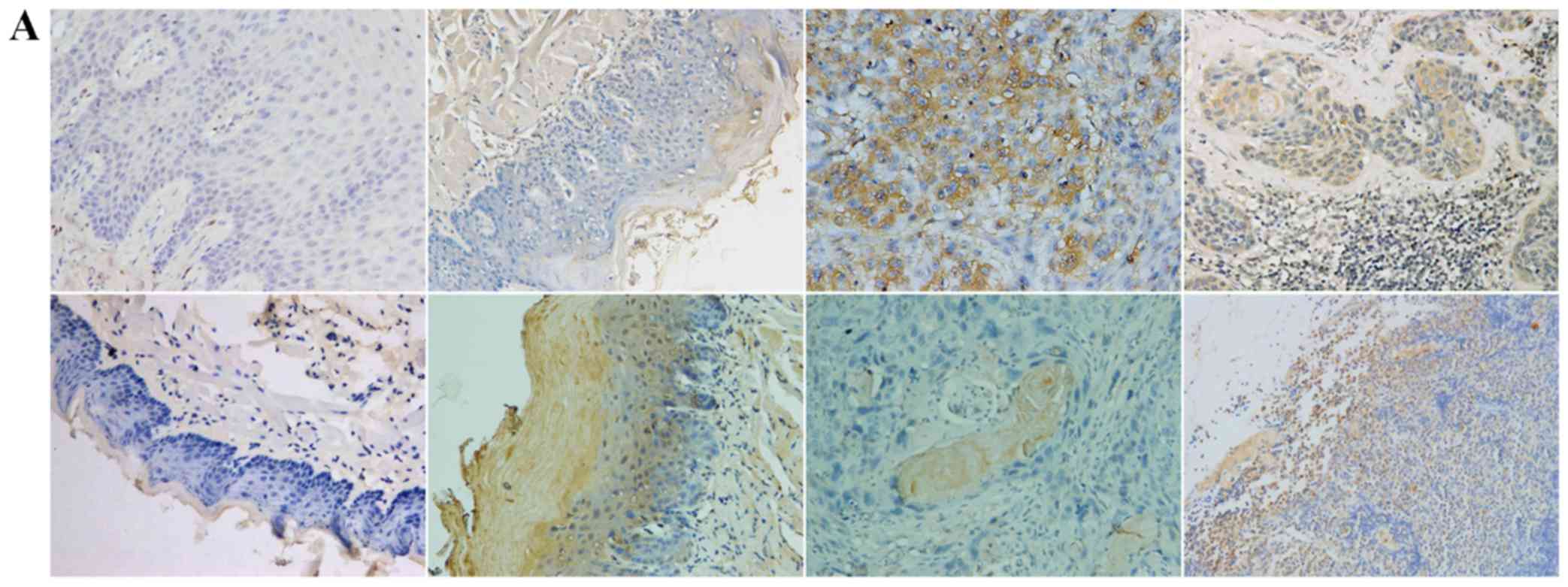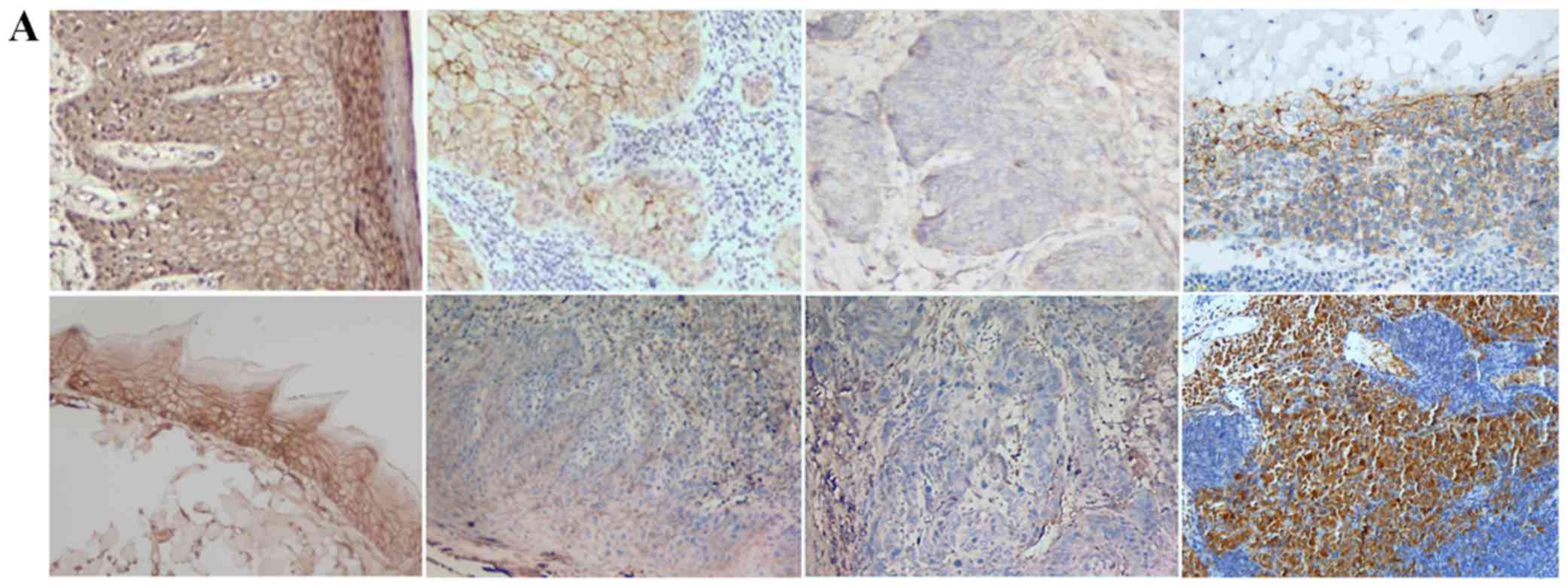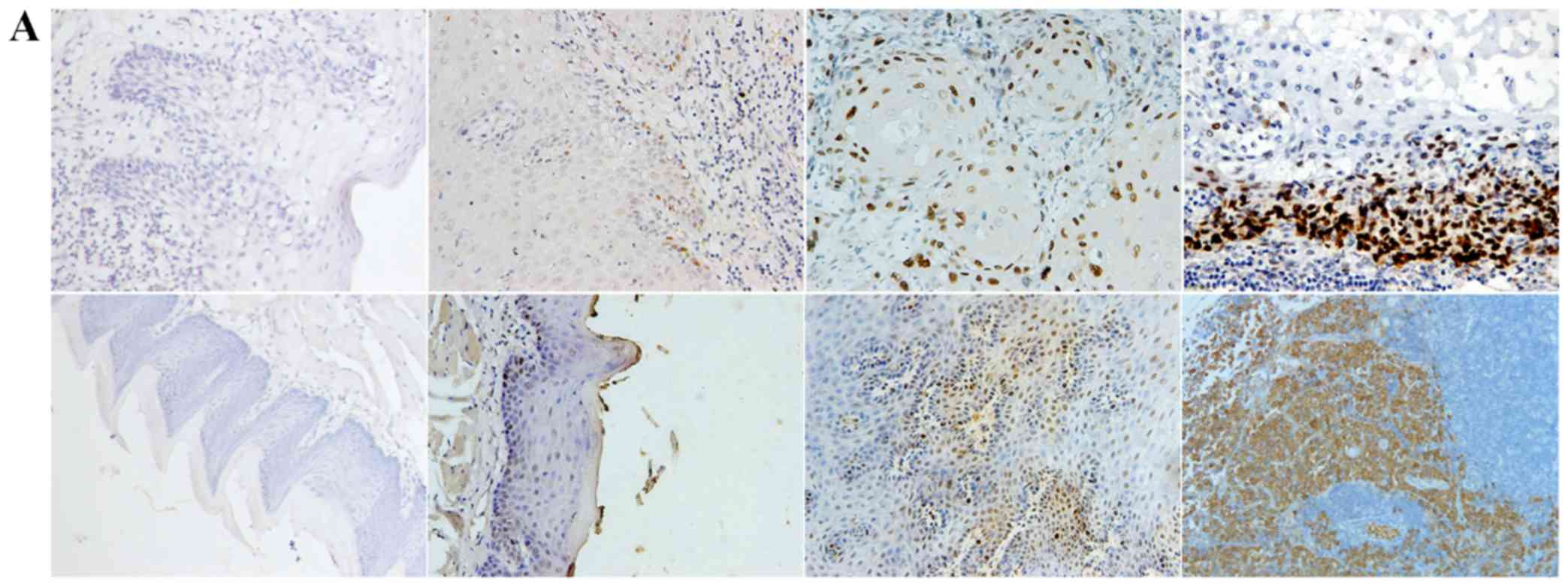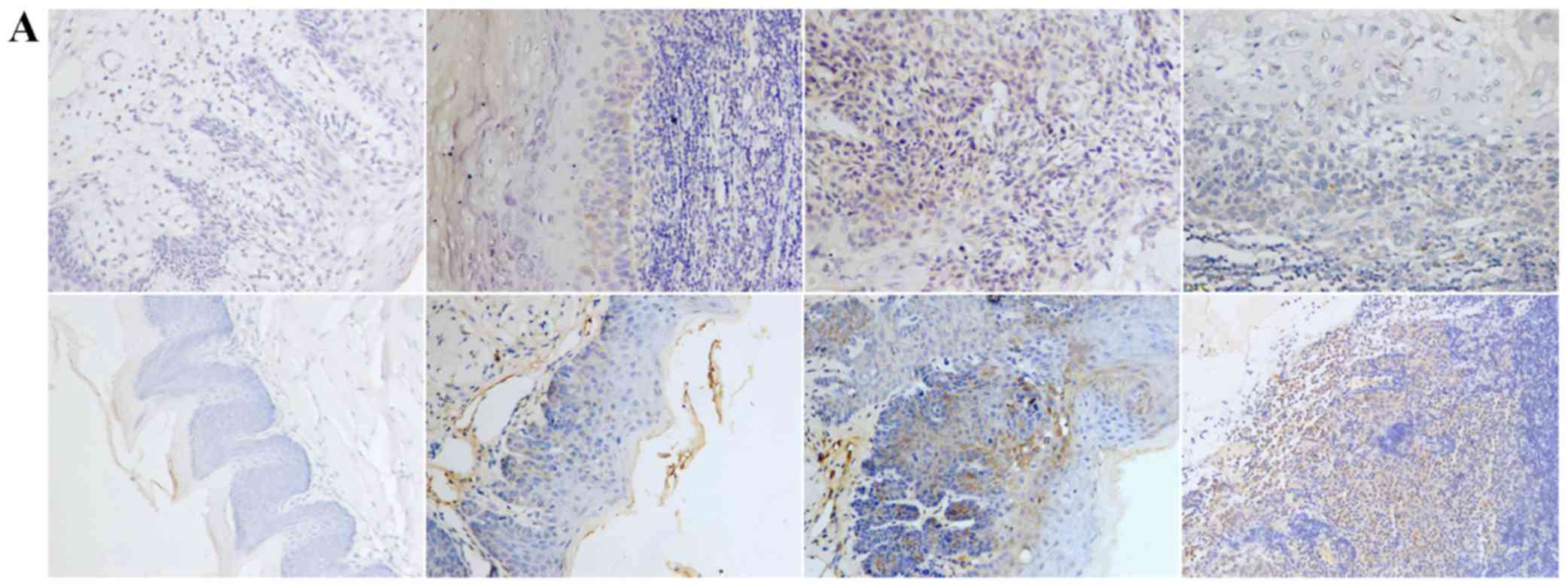Comparison of the expression of TGF‑β1, E‑cadherin, N‑cadherin, TP53, RB1CC1 and HIF‑1α in oral squamous cell carcinoma and lymph node metastases of humans and mice
- Authors:
- Published online on: November 21, 2017 https://doi.org/10.3892/ol.2017.7456
- Pages: 1639-1645
-
Copyright: © Guo et al. This is an open access article distributed under the terms of Creative Commons Attribution License.
Abstract
Introduction
The vast majority of oral cancers are squamous cell carcinomas and include cancers in the tongue, cheeks, mouth floor, lips and gingiva. This form of cancer usually originates from normal oral mucosa, which progresses to dysplasia, then to squamous cell carcinoma, and ultimately to metastatic carcinoma (1). Invasion and metastasis occur early in oral cancer; therefore, regional lymph node metastasis is an important factor in the high mortality of oral cancer. Many aspects of the mechanism of lymphatic metastasis from oral cancer are still unknown. Because of ethical reasons, it is very difficult to obtain continuous carcinoma specimens of oral cancer from dysplasia to metastasis from the same patients. Therefore, it is necessary to establish an animal model in which the development and the pathology of oral cancer echo those of the corresponding human cancers, especially in relation to the origin of lymphatic metastases.
Many studies indicate that the administration of 4-nitroquinoline-1-oxide (4NQO) to mice or rats effectively induces oral cancer that resembles oral tumor growth in humans (2–4). However, regional lymph node metastasis from oral cancer has barely been examined in the 4NQO model. In a previous study, we have described the development of a lymph node metastases from oral carcinoma mouse model through the long-term administration of high-dose 4NQO and a prolonged observation period (5). However, the molecular events that, in this model, occur at the different stages of oral tumor carcinogenesis have not yet been investigated. Furthermore, the biological and molecular similarities of oral cancer lymph node metastasis between this animal model and humans have not been examined. Thus, in the present study, we try to expolre this point by comparing the expressions of TGF (TGF)-β1, E-cadherin, N-cadherin, TP53, RB1CC1 and HIF-1α in different stages of oral squamous cell carcinoma (OSCC) in human and mouse.
The epithelial-mesenchymal transition (EMT) plays an important role in the dissemination and metastasis of oral cancer: It is characterized by the induction of a variety of cytokines and chemokines, which destroy normal cell adhesion, lead to the loss of cell-cell interaction, contribute to the recombination of cytoskeleton, cause cell invasion and eventually result in the dissemination and metastasis of oral cancer cells (6).
TGF-β1 plays a pivotal role in the activation of EMT. TGF-β1 is a cytokine with multifunctional biological activity, which can induce EMT by a variety of signal transduction mechanisms (7). In addition, TGF-β1 is involved in cell proliferation, differentiation, apoptosis, and plays an important role in immune regulation. The change of the expression and distribution of TGF-β1 in oral pre-cancerous lesions increase the risk of cancer (8).
E-cadherin and N-cadherin are important members of the family of cadherins, which are Ca2+-dependent cell adhesive glycoproteins. E-cadherin is expressed in epithelial tissues, while N-cadherin is expressed in neural tissues (9). During tumor invasion and metastasis, the replacement of E-cadherin with N-cadherin results in the loss of polarity and adhesion in epithelial cells; consequently, the epithelial cells acquire the characteristics of mesenchymal cells, and gain the ability to invade and metastasize. This change is an important process in EMT; therefore, the cadherin switch is considered a critical mechanism in tumor progression and metastasis (10).
The occurrence of many tumors is related to the activation of oncogenes, the inactivation of cancer suppressor genes, or a combination of both. TP53 is a cancer suppressor gene and is considered the defender of the genome. The inactivation of TP53 (also called p53) causes the loss of p53 tumor suppressor activity, promoting the malignant transformation of the cells. TP53 mutation is related to the pathologic grade, clinical stage and lymph node metastasis of human oral squamous cell carcinoma (OSCC). Changes in TP53 in cancer tissue are an independent factor for poor prognosis in OSCC (11,12).
RB1-Inducible Coiled-coil 1 (RB1CC1) plays a fundamental role in autophagosome formation (13). Studies had shown that autophagy can improve the adaptability of tumor cells: Through degradation of their components, normal cells can provide energy for the tumor cells (14). The evolutionary conserved protein encoded by RB1CC1 can interact with p53; together, RB1CC1 and p53 regulate multiple signaling pathways in the cells (13), thus controlling the cell cycle and inhibiting cell proliferation (15). A study has pointed that RB1CC1 is associated with early breast carcinogenesis (16).
Hypoxia is an important initiating factor in cancer. In the initial stage of cancer, local hypoxia activates hypoxia-inducible factor-1α (HIF-1α), which upregulates the expression of the downstream vascular endothelial growth factor (VEGF). VEGF induces the formation of blood and lymphatic vessels, and promotes the rapid proliferation of cancer cells (17–19).
By detecting and comparing the expression of the above described molecular biomarkers in normal oral mucosa, dysplasia, OSCC and lymph node metastases samples from patients and mice, the objective of this research had further demonstrated that the mouse model we built closely mimics the human oral carcinogenesis and lymphatic metastases, and to preliminarily explore the function of these biomarkers in the development of oral cancer.
Materials and methods
Patients
A total of 72 human samples (12 normal, 24 dysplastic, 24 OSCC and 12 lymph node-metastatic carcinoma) were obtained from the patients of the stomatological hospital affiliated to the Guangxi Medical University, from January 2012 to June 2016. The patients aged between 27 and 78 years and were an even mix of men and women. None of them received chemotherapy or radiation therapy before sample collection. The normal tissues were obtained from the gingiva, the dysplasia and OSCC tissues from the tongue and the lymph node metastasis carcinoma tissues from the neck lymph nodes of the patients. Informed consent was obtained from all the participants. The Human Ethics Committee of Guangxi Medical University, China, approved this study.
Animals
Mouse samples (9 normal, 20 dysplastic, 20 OSCC and 9 lymph node-metastatic carcinoma) were obtained from the Balb/c mouse model lymphatic metastases from oral carcinoma, induced by 4-NQO. The normal, dysplasia and OSCC tissues were obtained from the tongue and the lymph node metastasis carcinoma tissues were obtained from the submandibular lymph nodes of the mice. The Animal Ethics Committee of Guangxi Medical University, China, approved this study.
Samples
Specimens were fixed in 10% formalin, embedded in paraffin, and sectioned. Each specimen was stained with hematoxylin-eosin (HE) or immunohistochemical staining.
Immunohistochemistry assay (IHC)
The antibodies used in the present study were as follows: Mouse monoclonal antibodies for E-cadherin and p53 (ZSGB-Bio, China), rabbit polyclonal antibodies for TGF-β1 and HIF-1α (Boster Biological Technology, China), mouse monoclonal antibody for N-cadherin (Santa Cruz, USA), and rabbit polyclonal antibodies for RB1CC1 (Proteintech Group, China). All antibodies used in the present study were suitable for the detection of proteins in both humans and mouse.
Immunohistochemistry was performed on paraffin sections. Deparaffinized sections were pretreated with 0.4% pepsin for 60 min at 37°C. Endogenous peroxidase activity was quenched by treatment with 0.2% H2O2 for 3 h. The sections were then incubated with the specific antibodies overnight at 4°C. In addition, sections incubated with 0.01 mol/l phosphate buffer saline (PBS) and tongue cancer tissues incubated with the chosen antibodies were used as negative and positive controls, respectively. The immunostaining was visualized with an SP kit (ZSGB-Bio, China) using a diaminobenzidine-peroxidase substrate. The sections were counterstained with Mayer's hematoxylin and examined using the image analyzer of a light microscope (Leica Leitz DMRB/E, Leica Microsystems, Wetzlar, Germany).
Evaluation of the IHC results
TGF-β1, N-cadherin, TP53, RB1CC1, HIF-1a are expressed in the cytoplasm and E-cadherin is expressed in cytomembrane. IHC staining of these six proteins in the cells was scored subjectively under a light microscope and the percentage of stained tumor cells was expressed according to a previous study (20), with little modification as follows: 0–10% of cells stained, score 0; 11–25% of cells stained, score 1; 26–50% of cells stained, score 2; 51–100% of cells stained, score 3. Cells scoring 0/1 were considered to be negative, and those scoring 2/3 were considered to be positive.
Statistical analysis
The statistical analysis of the biological markers was performed using the Chi-square test. The correlation analysis was performed using the Spearman rank correlation test. The results were considered statistically significant if P<0.05.
Results
Positive expression of E-cadherin was mainly observed in the cytomembrane, in both human and mouse samples (Fig. 1A). Positive expression of TGF-β1, N-cadherin, p53, RB1CC1 and HIF-1α was mainly detected in the nucleus and the cytoplasm of cells, in both human and mouse samples (Figs. 2–6A).
Moreover, the positive rates of the above mentioned molecular biomarkers were analyzed and the results indicated that there were no obvious differences between human and mouse samples (P>0.05) (Figs. 1–6B-D). Figs. 1D and 2D point to a significant increase in the expression of TGF-β1 and N-cadherin in both human and mouse samples in the progression from normal mucosa to lymph node metastasis. Fig. 3D shows that the expression of E-cadherin decreases in the progression from normal mucosa to OSCC, but increases almost to its original amount in both human and mouse lymph node metastases. Figs. 4D and 5D indicates a significant increase in the expression of TP53 and RB1CC1 in both human and mouse samples in the progression from normal mucosa to lymph node metastasis. Additionally, the expression of p53 positively correlates with that of RB1CC1 in both human and mouse samples (r=0.971, P=0.029; r=0.97, P=0.03), correlation analysis by Spearman rank correation test. Fig. 6D shows that the expression of HIF-1α increases from normal mucosa to OSCC, but decreases in both human and mouse lymph node metastases.
Discussion
Our study found that samples from the mouse model of lymphatic metastases from oral cancer we built and human oral cancer shared the similar expression in a wide variety of biological molecular markers. Firstly, the expression of TGF-β1 at different stages of oral cancer was similar in samples from patients and from the mouse models, and it increased with the progression of the cancer both cases. This finding corroborates a study from Lu et al on head and neck squamous cell carcinoma (21) and agrees with the notion that TGF-β1 may promote EMT and accelerate tumor invasion and metastasis. Secondly, with the progression of cancer, the expression of E-cadherin decreased in mouse and human samples, meanwhile, the expression of N-cadherin increased. Hazan et al also reported the significant lack of E-cadherin in the most terminal breast cancers and the increased expression of N-cadherin (22). Studies on head and neck cancer, colorectal cancer, pancreatic cancer and esophageal cancer showed similar results (23–25). It is known that the switch from E-cadherin to N-cadherin may cause the loss of adhesion between cells, thus allowing tumor cells to leave the primary tumor and migrate, and eventually induce metastases. Our study also found that E-cadherin was re-expressed in both human and mouse lymph node metastases, similarly to what has been observed in ovarian cancer lymphatic metastases (26). Therefore, we speculate that when the cancer cells reach the targeted metastatic tissue, the re-expression of E-cadherin might promote cancer cell colonization in the invaded tissue: Cancer cells can, in such way, proliferate and invade to ultimately form metastases. There might be a dynamic adjustment of protein expression along with the change of microenvironment. In other words, the expression of E-cadherin is time-dependent and space-dependent. However, how this process starts and is fine-tuned needs further exploration.
Thirdly, the expression of p53 and RB1CC1 in oral mucosa dysplasia, OSCC and metastatic tissue from human and mouse samples were higher than in oral normal tissue, and the expression of p53 and RB1CC1 increased with progression of the cancer. Nishioka et al found that, in human oral squamous cell carcinoma, the expression of p53 increased with the progression of OSCC (27). Suraneni et al found that RB1CC1 was over-expressed in prostate cancer cells, and increased with the malignant degree of the cancer (28). Wei and Guan found that RB1CC1 might play a promoting role in early cancer in the MMTV-Pymt mouse model of human breast cancer (29). The studies above are consistent with our results. The possible explanation is that p53 and RB1CC1 play a promoting role in the procession of OSCC.
Our study also found that the expression of p53 correlates with that of RB1CC1. Morselli et al (30) found that p53 had a double effect on autophagy. The fraction of p53 located in the nucleus stimulates autophagy-inducing genes, while the fraction of p53 located in the cytoplasm had the opposite effect. Wei et al found that RB1CC1 regulated cell growth, division, proliferation, autophagy, and apoptosis through the nuclear cytoplasmic shuttle mechanism and multiple signaling pathways (31). The mutual regulation between p53 and RB1CC1 may be the necessary step to begin autophagy. When the tumor lacks nutrition, during its rapid growth phase, autophagy might allow the tumor to grow more quickly. Probably, the synergistic effect of p53 and RB1CC1 leads to the development of OSCC.
Finally, we found that the expression of HIF-1α at different stages of the oral cancer was similar in human and mouse samples. The positive expression rate of HIF-1α raised from normal to dysplastic oral mucosa, till reaching 100% in OSCC. Many studies suggest that HIF-1α is over-expressed in a variety of malignant human tumors (32). Bos et al found that the increased expression of HIF-1α is an independent factor predicting shorter prognosis in breast cancer (33). Aebersold et al also found that 94% of nasopharyngeal squamous carcinoma tissues had high expression of HIF-1α (34). However, the positive expression rate of HIF-1α in lymph node metastases decreased in both human and mouse samples. The possible explanation is that even though the primary cancer was anoxic, causing the increased expression of HIF-1α, the metastases of the lymph nodes might have had a good blood supply, therefore justifying the lower expression of HIF-1α.
The results of our comparative study show that the examined molecular markers in our mouse model of lymphatic metastases from oral cancer and in samples from patients had similar expression, and are probably the factors leading to the activation of tumor, blood vessel formation, autophagy, EMT, invasion and metastasis. In conclusion, the mouse model we built may mimic human oral cancer and may be valuable to study the mechanism of lymphatic metastases from oral carcinoma.
Acknowledgements
This study was supported by the National Nature Science founding of China (grant nos. 81360407 and 81360403) and the Guangxi Provincial Nature Science founding (grant no. 2013GXN5FAA019182).
References
|
Nauta JM, Roodenburg JL, Nikkels PG, Witjes MJ and Vermey A: Comparison of epithelial dysplasia-the 4NQO rat palate model and human oral mucosa. Int J Oral Maxillofac Surg. 24:53–58. 1995. View Article : Google Scholar : PubMed/NCBI | |
|
Tang XH, Knudsen B, Bemis D, Tickoo S and Gudas LJ: Oral cavity and esophageal carcinogenesis modeled in carcinogen-treated mice. Clin Cancer Res. 10:301–313. 2004. View Article : Google Scholar : PubMed/NCBI | |
|
Fisker AV, Philipsen HP and Overvad K: Dose-response relationship in complete oral 4NQO-carcinogenesis in rats. Acta Pathol Microbiol Immunol Scand A. 95:281–288. 1987.PubMed/NCBI | |
|
Jiang C, Ye D, Qiu W, Zhang X, Zhang Z, He D, Zhang P and Chen W: Response of lymphocyte subsets and cytokines to Shenyang prescription in Sprague-Dawley rats with tongue squamous cell carcinomas induced by 4NQO. BMC Cancer. 7:402007. View Article : Google Scholar : PubMed/NCBI | |
|
Li J, Liang F, Yu D, Qing H and Yang Y: Development of a 4-nitroquinoline-1-oxide model of lymph node metastasis in oral squamous cell carcinoma. Oral Oncol. 49:299–305. 2013. View Article : Google Scholar : PubMed/NCBI | |
|
Hayashida T, Jinno H, Kitagawa Y and Kitajima M: Cooperation of cancer stem cell properties and epithelial-mesenchymal transition in the establishment of breast cancer metastasis. J Oncol. 2011:5914272011. View Article : Google Scholar : PubMed/NCBI | |
|
Nawshad A, LaGamba D and Hay ED: Transforming growth factor beta (TGFbeta) signalling in palatal growth, apoptosis and epithelial mesenchymal transformation (EMT). Archiv Oral Biol. 4:675–689. 2004. View Article : Google Scholar | |
|
Massagué J, Blain SW and Lo RS: TGFbeta signaling in growth control, cancer, and heritable disorders. Cell. 103:295–309. 2000. View Article : Google Scholar : PubMed/NCBI | |
|
Wheelock MJ and Johnson KR: Cadherins as modulators of cellula phenotype. Annu Rev Cell Dev Biol. 19:207–235. 2003. View Article : Google Scholar : PubMed/NCBI | |
|
Gravdal K, Halvorsen OJ, Haukaas SA and Akslen LA: A switch from E-cadherin to N-cadherin expression indicates epithelial to mesenchymal transition and is of strong and independent importance for the progress of prostate cancer. Clin Cancer Res. 13:7003–7011. 2007. View Article : Google Scholar : PubMed/NCBI | |
|
Bargonetti J and Manfredi JJ: Multiple roles of the tumor suppressor p53. Curr Opin Oncol. 14:86–91. 2002. View Article : Google Scholar : PubMed/NCBI | |
|
Tokino T and Nakamura Y: The role of p53-target genes in human cancer. Crit Rev Oncol Hematol. 33:1–6. 2000. View Article : Google Scholar : PubMed/NCBI | |
|
Wei H, Wei S, Gan B, Peng X, Zou W and Guan JL: Suppression of autophagy by FIP200 deletion inhibits mammary tumorigenesis. Genes Dev. 25:1510–1527. 2011. View Article : Google Scholar : PubMed/NCBI | |
|
Lebovitz CB, Robertson AG, Goya R, Jones SJ, Morin RD, Marra MA and Chandra B: Cross-cancer profiling of molecular alterations within the human autophagy interaction network. Autophagy. 11:1668–1687. 2015. View Article : Google Scholar : PubMed/NCBI | |
|
Wei H, Wei S, Gan B, Peng X, Zou W and Guan JL: Screening for microsatellite instability identifies frequent 3′-untranslated region mutation of the RB1-inducible coiled-coil 1 gene in colon tumors. PLoS One. 4:e77152009. View Article : Google Scholar : PubMed/NCBI | |
|
Schmidt-Kittler O, Ragg T, Daskalakis A, Granzow M, Ahr A, Blankenstein TJ, Kaufmann M, Diebold J, Arnholdt H, Muller P, et al: From latent disseminated cells to overt metastasis: Genetic analysis of systemic breast cancer progression. Proc Natl Acad Sci USA. 100:pp. 7737–7742. 2003; View Article : Google Scholar : PubMed/NCBI | |
|
Hanahan D and Folkman J: Patterns and emerging mechanisms of the angiogenic switch during tumorigenesis. Cell. 86:353–364. 1996. View Article : Google Scholar : PubMed/NCBI | |
|
Raica M, Cimpean AM and Ribatti D: Angiogenesis in pre-malignant conditions. Eur J Cancer. 45:1924–1934. 2009. View Article : Google Scholar : PubMed/NCBI | |
|
Folkman J, Watson K, Ingber D and Hanahan D: Induction of angiogenesis during the transition from hyperplasia to neoplasia. Nature. 339:58–61. 1989. View Article : Google Scholar : PubMed/NCBI | |
|
Jammal MP, Da Silva A, Filho AM, DE Castro Côbo E, Adad SJ, Murta EF and Nomenili RS: Immunohistochemical staining of tumor necrosis factor-α and interleukin-10 in benign and malignant ovarian neoplasms. Oncol Lett. 9:979–983. 2015.PubMed/NCBI | |
|
Lu SL, Reh D, Li AG, Woods J, Corless CL, Kulesz-Martin M and Wang XJ: Overexpression of transforming growth factor beta1 in head and neck epithelia results in inflammation, angiogenesis, and epithelial hyperproliferation. Cancer Res. 64:4405–4410. 2004. View Article : Google Scholar : PubMed/NCBI | |
|
Hazan RB, Phillips GR, Qiao RF, Norton L and Aaronson SA: Exogenous expression of N-cadherin in breast cancer cells induces cell migration, invasion, and metastasis. J Cell Biol. 148:779–790. 2000. View Article : Google Scholar : PubMed/NCBI | |
|
Nguyen PT, Kudo Y, Yoshida M, Iizuka S, Ogawa I and Takata T: N-cadherin expression is correlated with metastasis of spindle cell carcinoma of head and neck region. J Oral Pathol Med. 40:77–82. 2011. View Article : Google Scholar : PubMed/NCBI | |
|
Nakajima S, Doi R, Toyoda E, Tsuji S, Wada M, Koizumi M, Tulachan SS, Ito D, Kami K, Mori T, et al: N-cadherin expression and epithelial-mesenchymal transition in pancreatic carcinoma. Clin Cancer Res. 10:4125–4133. 2004. View Article : Google Scholar : PubMed/NCBI | |
|
Yoshinaga K, Inoue H, Utsunomiya T, Sonoda H, Masuda T, Mimori K, Tanaka Y and Mori M: N-cadherin is regulated by activin A and associated with tumor aggressiveness in esophageal carcinoma. Clin Cancer Res. 10:5702–5707. 2004. View Article : Google Scholar : PubMed/NCBI | |
|
Davidson B, Gotlieb WH, Ben-Baruch G, Nesland JM, Bryne M, Goldberg I, Kopolovic J and Berner A: E-cadherin complex protein expression and survival in ovarian carcinoma. Gynecol Oncol. 79:362–371. 2000. View Article : Google Scholar : PubMed/NCBI | |
|
Nishioka H, Hiasa Y, Hayashi I, Kitahori Y, Konishi N and Sugimura M: Immunohistochemical detection of p53 oncoprotein in human oral squamous cell carcinomas and leukoplakias: Comparison with proliferating cell nuclear antigen staining and correlation with clinicopathological findings. Oncology. 50:426–429. 1993. View Article : Google Scholar : PubMed/NCBI | |
|
Suraneni MV, Moore JR, Zhang D, Badeaux M, Macaluso MD, Digiovanni J, Kusewitt D and Tang DG: Tumor suppressive functions of 15-Lipoxygenase-2 and RB1CC1 in prostate cancer. Cell Cycle. 13:1798–1810. 2014. View Article : Google Scholar : PubMed/NCBI | |
|
Wei H and Guan JL: Pro-tumorigenic function of autophagy in mammary oncogenesis. Autophagy. 8:129–131. 2012. View Article : Google Scholar : PubMed/NCBI | |
|
Morselli E, Shen S, Ruckenstuhl C, Bauer MA, Mariño G, Galluzzi L, Criollo A, Michaud M, Maiuri MC, Chano T, et al: P53 inhibits autophagy by interacting with the human orthologue of yeast Atg17, RB1CC1/FIP200. Cell Cycle. 10:2763–2769. 2011. View Article : Google Scholar : PubMed/NCBI | |
|
Wei H, Wei S, Gan B, Peng X, Zou W and Guan JL: Suppression of autophagy by FIP200 deletion inhibits mammary tumorigenesis. Genes Dev. 25:1510–1527. 2011. View Article : Google Scholar : PubMed/NCBI | |
|
Zhong H, De Marzo AM, Laughner E, Lim M, Hilton DA, Zagzag D, Buechler P, Isaacs WB, Semenza GL and Simons JW: Overexpression of hypoxia-inducible factor 1alpha in common human cancers and their metastases. Cancer Res. 59:5830–5835. 1999.PubMed/NCBI | |
|
Bos R, van der Groep P, Greijer AE, Shvarts A, Meijer S, Pinedo HM, Semenza GL, van Diest PJ and van der Wall E: Levels of hypoxia-inducible factor-1alpha independently predict prognosis in patients with lymph node negative breast carcinoma. Cancer. 97:1573–1581. 2003. View Article : Google Scholar : PubMed/NCBI | |
|
Aebersold DM, Burri P, Beer KT, Laissue J, Djonov V, Greiner RH and Semenza GL: Expression of hypoxia-inducible factor-1alpha: A novel predictive and prognostic parameter in the radiotherapy of oropharyngeal cancer. Cancer Res. 61:2911–2916. 2001.PubMed/NCBI |



